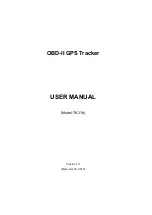
Autopilot
To control the autopilot, "Ikarus OSD" integrates 4 PID controllers, two of them for the aircraft
stabilization (pitch and roll control) and two for the heading and altitude control. If you use the
"normal" or "non-PPM" mode, only used the last two. The heading and altitude controls will drive
rudder and motor channels, while stabilization will control ailerons and elevator. Additionally, the
output of the heading and altitude PID can be used to change the attitude of the aircraft, and therefore
the degree of pitch and roll to be taken.
Usually it's not necessary to use the full PID (Proportional-Integral-Derivative), but simply the
Proportional (P control) or Propor Integral (PI control). The output of all the controllers may be
restricted in travel, and also may limit the value that integral takes.
If you are unfamiliar with a PID controller, in Internet you will find a large number of
references of its operation and adjustment techniques. To begin, start by adjusting only the P factor
(leaving the I and D gains to zero). A very high value will cause the plane to oscillate. A very low
value will cause the signal control insufficient. Once behaving properly, but note that you have
difficulty completing the desired point (for example, has good control of altitude, but always remains
slightly above or below the exact height indicated), increase the factor I progressively without reaching
oscillations (do not forget that the integral limit is not set to zero).
Mixing
To adequately manage the different types of aircraft, you may need to use one of the mixtures
that "Ikarus OSD” supports . This requires the use of PPM mode. While piloting in manual mode, the
OSD will just send the information from the PPM signal receiver to the servos, so mixing it's made at
the R/C transmitter side. However, when you want to use the autopilot, you must set the mixing
properly.
Typically, traditional aircraft with ailerons, rudder and elevator no need to use any type of mix.
However, for flying with flying wings and V-tailed aircraft, you must choose the appropriate mixing
mode.
•
Normal: No mixing. We have, ailerons, elevator, rudder and motor on different
channels.
•
Elevon: Used in flying wings. In this case, the same control surfaces will serve as
elevator and aileron, so both channels are mixed.
•
V-Tail: The V-tail, mixing the rudder and deep
Telemetry
Telemetry consist in sending aircraft's information to the ground station. Among the
information that is sent from the plane is the aircraft's position (longitude, latitude and altitude),
heading, aircraft attitude (pitch and roll angles), the speed and rate of ascent or descent (vertical
velocity). Also sends the voltage level of the two batteries, the level at which you receive the radio
signal (RSSI), and the coordinates of the next waypoint. With all these data, the flight console can
placed on the map the plane and the point you are going to. It may also correctly update the various
virtual instruments (speedometer, altimeter, compass, artificial horizon and variometer) to show the
© Ikarus Team Sevilla 2010
Page. 4/60




































